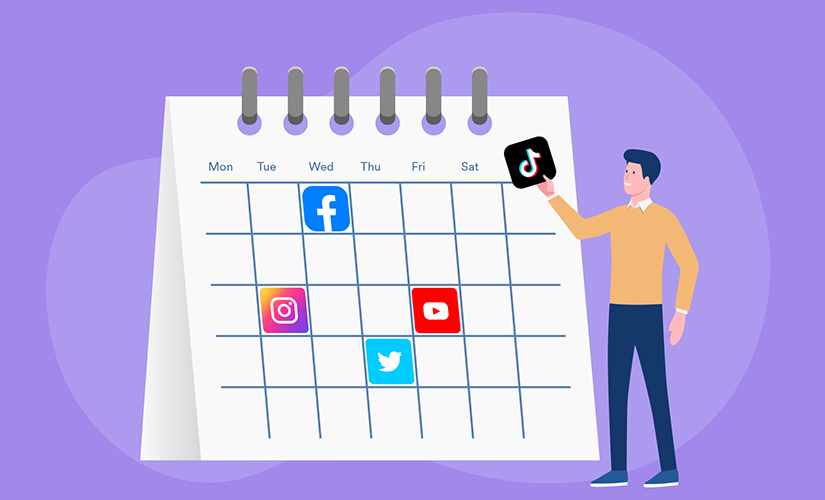In today’s digital landscape, a well-organized social media content calendar is essential for businesses and marketers. It helps streamline your content strategy, ensuring consistency and engagement across platforms. Whether you’re a small business owner or part of a larger marketing team, here are some effective tips for creating a social media content calendar that drives results.

Table of Contents
Toggle1. Define Your Goals
Before you start creating your content calendar, it’s essential to define your social media goals. Are you aiming to increase brand awareness, drive website traffic, generate leads, or boost engagement? Having clear objectives will guide your content creation process and help you measure success. Make sure your goals are SMART: Specific, Measurable, Achievable, Relevant, and Time-bound.
2. Know Your Audience
Understanding your target audience is crucial for creating content that resonates with them. Conduct audience research to identify demographics, preferences, and pain points. Use social media analytics and insights to gather data on your audience’s behavior, such as the best times to post and the types of content they engage with. Tailoring your content to meet their interests will enhance engagement and drive more traffic.
3. Choose Your Platforms Wisely
Not all social media platforms are created equal, and each serves different purposes. Determine which platforms align with your goals and where your audience is most active. Focus on quality over quantity; it’s better to have a strong presence on a few platforms than a weak presence on many. Consider platforms like:
- Facebook: Ideal for community building and customer engagement.
- Instagram: Great for visual storytelling and brand aesthetics.
- Twitter: Effective for real-time updates and customer service.
- LinkedIn: Best for B2B marketing and professional networking.
- TikTok: Engaging for reaching younger audiences with creative content.
4. Plan Content Types and Themes
Variety is key to keeping your audience engaged. Plan different types of content, such as:
- Educational Posts: Share tips, how-tos, or industry insights.
- Promotional Content: Highlight products, services, or special offers.
- User-Generated Content: Encourage followers to share their experiences.
- Behind-the-Scenes: Showcase your team, processes, or company culture.
- Engagement Posts: Create polls, questions, or challenges to interact with your audience.
You can also establish monthly themes to keep your content fresh and relevant. For example, you might focus on sustainability in April or highlight customer success stories in December.
5. Create a Posting Schedule
Establishing a consistent posting schedule helps maintain audience engagement. Determine how often you want to post on each platform, keeping in mind that frequency can vary by channel. Use analytics to identify the best times to post for maximum visibility and engagement.
Create a visual calendar or spreadsheet to outline your posting schedule, specifying:
- Content Type: What kind of post will it be?
- Platform: Where will it be published?
- Date and Time: When will it go live?
- Copy and Visuals: Any text, images, or links needed.
6. Use Tools for Efficiency
Consider using social media management tools to streamline the content creation and scheduling process. Tools like Hootsuite, Buffer, or Sprout Social can help you schedule posts in advance, monitor engagement, and analyze performance across multiple platforms. This can save you time and allow you to focus on creating quality content.
7. Incorporate Seasonal and Trending Topics
Stay relevant by incorporating seasonal events, holidays, or trending topics into your content calendar. Planning ahead for holidays like Valentine’s Day, Halloween, or Black Friday can help you create timely promotions and engagement opportunities. Use Google Trends and social media listening tools to identify popular topics and hashtags in your industry.
8. Collaborate with Your Team
Creating a social media content calendar should be a collaborative effort. Involve team members from different departments, such as marketing, sales, and customer service, to gather diverse perspectives and ideas. Regular brainstorming sessions can lead to fresh content concepts and ensure everyone is aligned with the strategy.
9. Monitor and Adjust
Once your content calendar is live, regularly monitor its performance. Use social media analytics to track engagement metrics, such as likes, shares, comments, and click-through rates. Analyze which types of content perform best and adjust your strategy accordingly. Be flexible and willing to make changes based on audience feedback and trends.
10. Review and Revise Regularly
A social media content calendar is not a one-time project; it requires ongoing review and revision. Schedule regular check-ins (monthly or quarterly) to assess the effectiveness of your content strategy. Discuss what’s working, what isn’t, and what new trends or opportunities may have arisen. Use these insights to refine your calendar and keep your content fresh.
Conclusion
Creating a social media content calendar is an invaluable strategy for any business looking to enhance its online presence. By setting clear goals, understanding your audience, and maintaining consistency, you can develop engaging content that resonates with your followers. With careful planning and regular adjustments, your content calendar can become a powerful tool for driving engagement and achieving your marketing objectives. Start building your content calendar today, and watch your social media strategy thrive!


No responses yet